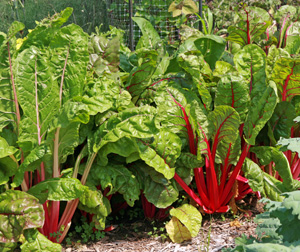
Swiss chard (Beta vulgaris L. var. cicla in the Family Chenopodiaceae) is a type of beet that does not produce an edible root. Also know as silverbeet (mainly in New Zealand and Australia), chard is a biennial plant grown as an annual for its rosette of big crinkly leaves and/or wide crunchy stems.
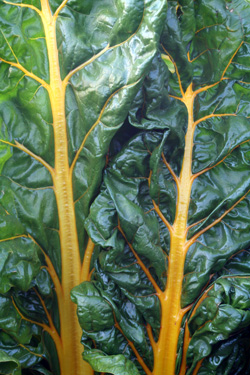
The leaves are very similar to beet greens, but have prominent, enlarged midribs and are borne on stout petioles. Chard is also a decorative plant that can be used as an ornamental in the flower garden.
Native to the Mediterranean, it was a popular food even before the days of the Roman Empire. It was once grown exclusively to be eaten at Christmas in the south of France, and constituted the highlight of the Christmas Eve meal. Only the petioles, with a flavor reminiscent of artichoke hearts, were eaten.
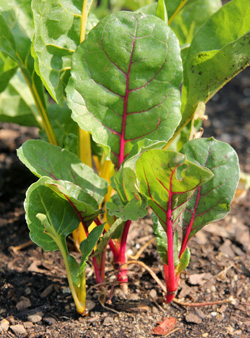
Chard prefers cool temperatures as high temperatures slow down leaf production but it tolerates heat better than spinach does and rarely bolts like spinach will.
Swiss chard grows well regardless of soil type, daylength or temperature. You can plant chard from seed (actually seed clusters which contain several seeds), about a month before the average date of last frost through midsummer. You can also start plants indoors to transplant out later.
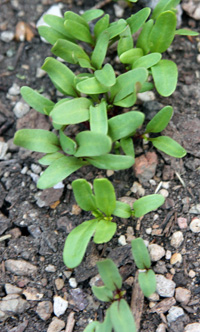
Chard does best in full sun, although it tolerates partial shade and likes fertile, well-worked soil with good drainage and high organic content. Plant the seeds an inch deep and 4-6″ apart. Thin to about a foot apart when the plants are easy to handle.
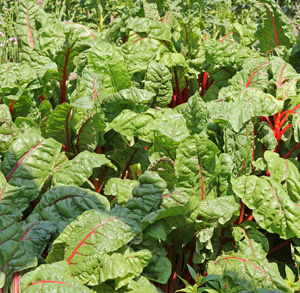
The small plants can also be transplanted if desired. Thinning isn’t as important as with beets, though. If chard plants are crowded they will just produce smaller leaves but more of them.
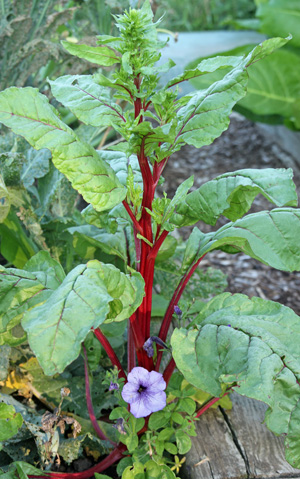
Remove any plants that bolt. Provide average fertilizer and moisture. Although the plants will tolerate some drying, they produce best when the soil is kept evenly moist.
Swiss chard does not have many insect or disease problems. Aphids and spinach leafminer occasionally infest chard but there are no serious disease problems. Aphid infestations can be removed by hosing off the plants, using insecticidal soap, or waiting for natural enemies such as ladybeetles, green lacewing larvae, or syrphid fly larvae to eat them. Leafminers feed internally in the leaves, so any leaves with mines should just be removed and discarded. Lamb’s-quarters (Chenopodium album) is a wild host of the leafminer which commonly grows in and around, so flies may continue to move in from infested weeds in nearby areas.
There many varieties of Swiss chard available. The main differences are petiole and leaf color. Petiole and midrib colors vary from white to yellow, orange, red or green, while leaves may be green, bronze or purple. These are some of the most common ones:
-

‘Bright Lights’ chard.
‘Bright Lights’ is a 1998 All-American Selection improved for its stem colors. The petioles can be white, yellow, gold, orange, pink, red or striped. This variety is excellent as an ornamental. 55 days to maturity. - ‘Fordhook Giant’ has broad, thick white midribs and petioles, with heavily crinkled, dark green leaves. The plants grow 24-28 inches tall.
- ‘Lucullus’ is an older variety that produces very broad and thick, white or pale green petioles. The leaves are dark green and crumpled. It is an excellent variety for freezing that matures in 55 days.
- ‘Neon Lights’ is a mixture of five colors that are more intense than ‘Bright Lights’.
- ‘Rainbow’ is a blend of several colored varieties.
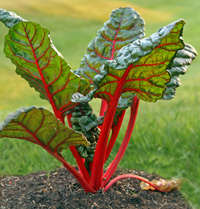
‘Rhubarb’ chard. - ‘Rhubarb’ produces crumpled, dark green leaves with deep red veins. The petioles are bright crimson red and slightly flattened. This attractive 20- to 24-inch plant matures in 60 days and is also nice as an ornamental. (Don’t confuse this variety with a real rhubarb plant – that plant has poisonous leaves.)
- ‘Silverado’ is a compact green variety that only grows 14-16″ tall. chard which may be harvested for individual stems or harvested as a whole plant. The broad white stems and crumpled, glossy dark green leaves can be harvested individually or as a whole plant. The compact and attractive plants mature in 60 – 65 days.
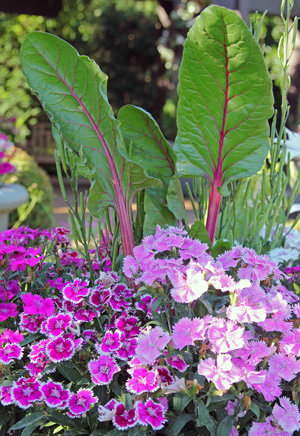
Swiss chard doesn’t have to be relegated only to the vegetable garden. The brightly colored petioles and wide, dark green leaves are quite attractive and are easily incorporated into the landscape as an annual ornamental foliage plant. Position chard plants with their bold foliage near plants with small or fine leaves for textural contrast. Select cultivars with dark-colored leaves
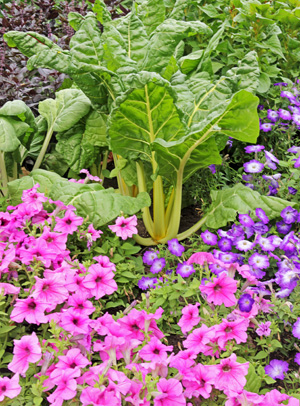
to provide color contrast amid all-green plants. Place chard plants near the edge of plantings where their colorful petioles will show off and provide some vertical
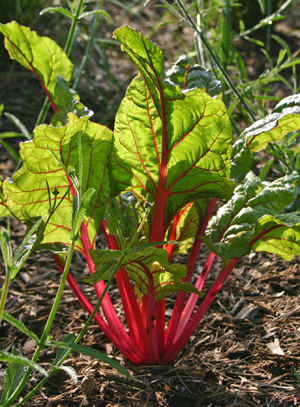
interest near low or mounded plants. They are particularly nice when viewed with the sun behind the leaves, setting the leaf blades aglow. Try combining chard with petunias or dianthus or other low-growing annual flowers for a dramatic statement in the annual or mixed bed.
You can start harvesting the leaves when they are about 3″ long (about 4 weeks after planting) and remove a few leaves at a time for a continuous harvest throughout the growing season. Or you can wait until the plant is more mature to cut all the leaves off as a bunch at about 3″ above the soil surface and let it grow back. The time from planting to bunch harvesting varies by variety but is generally about 2 months.
Leaves are best when just fully expanded or slightly earlier. Harvest Swiss chard early or late in the day, since the leaves wilt quickly when picked on a warm day in full sun. Break or cut off individual outer leaves near base of plant, being careful not to damage the inner leaves or growing points.

The leaves may turn somewhat bitter in mid-summer but if you continue to remove older leaves the plant will produce more leaves that will be less bitter as the weather cools. Swiss chard is quite cold tolerant and will continue to grow in the garden through frosts until temperatures drop to the mid-20’s. A cold frame usually ensures fresh chard well into December in southern Wisconsin.
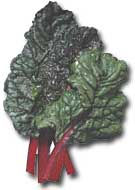
Chard can be stored (unwashed) for one to two weeks in the refrigerator. It is best fresh but can also be frozen, dried or canned. Young chard leaves have a sweet taste like spinach, so chard is often used like spinach. Use the small leaves in salads and larger, older leaves cooked. The older leaves are a good substitute for cooked spinach in various recipes.
– Susan Mahr, University of Wisconsin – Madison





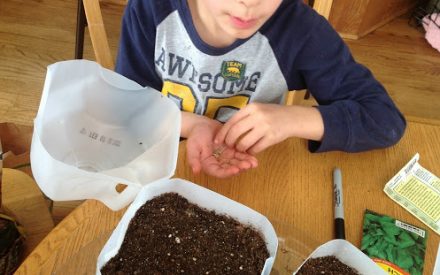 Seed Starting
Seed Starting Growing Vegetables at Home: Questions and Answers
Growing Vegetables at Home: Questions and Answers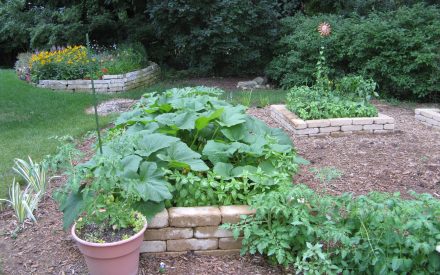 Growing Vegetables in Containers
Growing Vegetables in Containers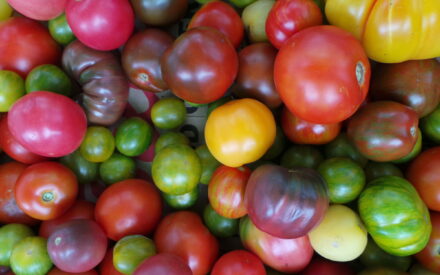 Homegrown Tomatoes for Wisconsin
Homegrown Tomatoes for Wisconsin


